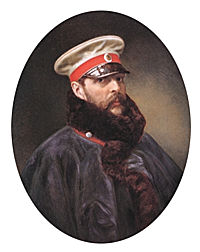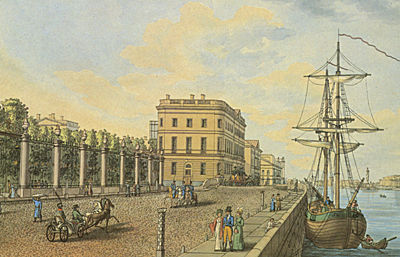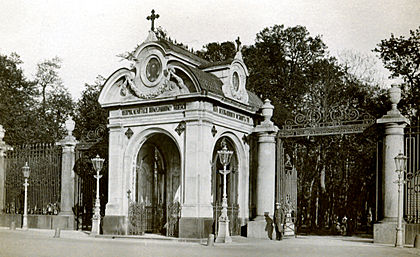
A well-known view of Petersburg in 1900 was the line of coachmen in their carriages waiting for customers in front of the railing of the Summer Garden. The beautiful Neva-side railing of the garden was designed by the architect Veldten around 1760 and it was one of the proudest ornaments of the city. The railing was built of granite columns, crowned with vases, which are linked by metal railings with neo-classical motifs and gilt highlights. Straight ahead - on the right in the middle of the sidewalk - can be seen a chapel which was built to commemorate the historic events on the 4th/16th April 1866 which occurred here.
Straight ahead - on the right in the middle of the sidewalk - can be seen a chapel which was built to commemorate the historic events on the 4th/16th April 1866 which occurred here.
Right: Alexander II. On that day, as was his habit, Tsar Alexander II was walking in the park. At that time a Tsar could move freely among his subjects without fear. On this visit he was accompanied by a nephew and niece. As he passed through the park people cheered and tossed their hats in the air, while Alexander smiled and saluted in return. It was the end of his visit and the Tsar was in the process of returning to his carriage which was waiting for him outside the railing of the park. A large crowd of people was waiting to see the Tsar depart - cheering and shouting hurrahs. Suddenly - and without warning - a shot rang out from the crowd surrounding the carriage and a bullet flew by, just missing the Tsar and hitting the ground behind him. For just a moment there was a leaden, still silence - as if everyone was drawing their breath at the same time in startled disbelief. Shouting, screaming and was followed by the noise of tumult of a crowd pouncing on the attempted assassin, who turned out to be an expelled university student named Dmitry Karakozov.
 Above: The Railing of the Summer Garden. It was a close call for Alexander, which might have succeeded except for the intervention of hatter's apprentice named Ossip Kommissarov who saw the raised arm of the assassin - revolver in hand - and instinctively sharply elbowed him, thus saving the Tsar's life. Poor Kommissarov! In the following confusion he lost his hat and found himself was pushed up to the Tsar's carriage where Alexander himself thanked and embraced him. More shouting and hurrahs - now for Kommissarov the hero! Everyone in the crowd wanted to hug and kiss him in thanks for saving Alexander, who was very popular at the time. Crushed and confused, all Kommissarov could do was cry in fright - it all happened so fast he hardly knew what had happened.  Above: Chapel built on the site of the attempted assassination.
The whole city was shocked - this was the first attempt on the Tsar's life. Thousands of people left their homes and shops and went to the Winter Palace where they waiting to make sure their Tsar was safe. News of the event travelled fast - and was all over the world in days. In July a special delegation from the US Congress and President Johnson arrived in Petersburg to convey to Alexander personally the congratulations of the American people on the Tsar's miraculous escape. America knew what it meant to loose a leader to an assassin, Lincoln's murder had only been a few months earlier.
Kommissarov was given a noble title, a diamond ring, the Tsar's portrait and a generous pension - all as a reward. Overwhelmed with fame he died a few years latter from alcoholism back in his hometown of Kostroma. The assassin was tried and hanged.
The chapel was built in the style of the railing, but it didn't last long. After the revolution the Bolsheviks destroyed the chapel and made a hero of the assassin.
Next photograph: Strolling In the Summer Garden
For a small map of the St. Petersburg area click here.
To see a large map of the center
of St. Petersburg go here.
Comments on the website should be sent to Bob
Atchison. | 
